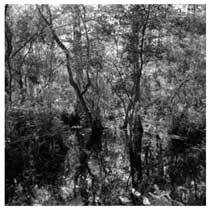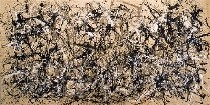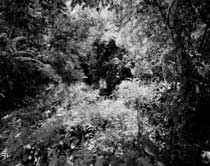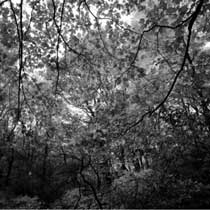
Stuart Rome‘s photographs of deep forest thickets on view at Gallery 339 until July 24 have a kind of excessive exuberance that reminds me of the wild and wooly drip paintings of Jackson Pollock and the dotted wonder worlds of Trudy Kraft. Of course Rome’s black and white photographs don’t resemble either one of those painters’ paintings. But the nature photographs have this in common with Pollock and Kraft. They are seducers able to draw the viewer into their swirling, overlapping layers of dots and lines, swoops and frothy light and, while they’re not at all mandala-like, Rome’s photographs have hypnotic charm. (top image is a shot taken in a Florida swamp. Notice the almost mesmerizing twinning in the shot)

Gallerist Martin McNamara was puzzling over the fact that some people look at Rome’s forest photographs say “Ah, Ray Metzger-like.” McNamara knows his Metzgers (he showed me two — also sylvan woodland scenes — also beautiful) and pointed out some differences between the two photographers’ takes on similar subject matter. (here’s Pollock’s “Autumn Rhythm”)
As we gazed back and forth at the Romes and the Metzger’s I had this thought. For me, and I’ll admit I’m basing this on the two Metzger works I saw (and my knowledge of the photographer’s non-forest works, like those on view at Locks), Metzger’s forest photographs tell the story of the woods seen by one on the outside looking in. There is a distinction between photographer and subject in these photos which describe something beautiful but do so one stepped removed, the analytical eye and mind at work framing the view. The two Metzger works I saw showed almost a playfulness — the artist’s mind and eye finding an incredible black hole of a tree sitting in the midst of an otherwise whited out scene. It was interesting intellectually and puzzling in an amusing way.
Rome’s works on the other hand, don’t have that analytical distance between photographer and subject. They feel like they were taken by someone at one with the scene — smitten, perhaps, by nature and willing to be the acolyte for others. I guess Rome’s works are romantic.

McNamara pointed out that many of the works have a circular motif which is evocative of going in to a deeper more spiritual place. “Presence Bali 1994” (shown at right) and “Tinicum Philadelphia 1997” are two examples. Not only do they have circular motifs within their square format scenes but they have a beguiling, “come hither” quality that’s most sexy. Rome in these works is playing shaman. Showing a world of delights that can transport you to a higher realm. Like the Transcendentalists before him, Rome is pointing to the mysical in nature, the spiritual. Which is not to say he doesn’t frame the shot and analyze with his mind. But the oneness of artist with subject is pretty complete. You don’t feel that analytical space in between like you do in the Metzgers I saw.
Rome’s photographs are taken in places all over the globe. Some of the nicest are close to home, in Fairmount Park, Tinicum and other places in Pennsylvania. The artist uses a medium focus camera, a Hasselblad, McNamara said. And these works have been compiled into a book, “Forest,” forthcoming any minute, published by Nasraeli, a fine art publisher that specializes in excellent quality small editions. The gallery hopes to have some of the books in in July and will have a book signing in the fall.

Meanwhile, news of upcoming events at the new gallery: They’re planning an emerging artist show in August with (the list’s incomplete but here are some names): Sarah Stolfa (a Drexel grad whose work is currently in the Drexel student show at Nexus). Stolfa, a student of Rome’s has a portrait series, “McGlinchy’s” that got some notoriety last year. Robert Rascka, a Pittsburgh photographer who’s not exactly emerging but is underexposed here, will be in the show and two CFEVA affiliates, Serge J.F. Levy, a street photographer, and Jackie Fugere who uses solarization in her prints on the theme of luck and chance (I saw both those artists’ works in a CFEVA show recently. See post) (last image is Rome’s “Fiery Leaves Begin to Drop”)
Anyway, inspired by Rome’s ardor for the forest, I ran up to the PMA to see the group photography exhibit of black and white flower and forest scenes, “Silver Garden.” More on that in another post.









